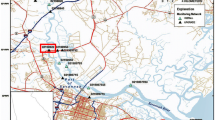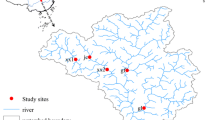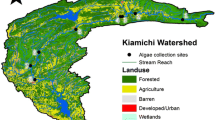Abstract
The flow regime of the Wimmera River was substantially modified due to the construction of a water supply reservoir. Samples of diatoms and soft algae and measurements of water quality were analysed at ten sampling sites for 3 years (between February 2012 and November 2014) along the MacKenzie River, a tributary of the Wimmera River, in different seasons and under different flow regimes, to understand the spatial and temporal variation in the relationship between algal communities, water quality and stream condition. Baseline information on algal communities and water quality was collected during base flow conditions, while experiments on the effect of water releases on algal communities were based on flow regime variations (manipulated flow regimes), specifically on the algae community structure, water quality and ecosystem function. Algal species composition changed along the river under different flow regimes and different seasons. Under base flow, Bacillariophyta (diatoms) were more abundant upstream, and filamentous green algae were more abundant downstream. The results showed that the algal composition shifted downstream after water release events. Chlorophyta (green algae), Cyanophyta (blue-green algae) and Chrysophyta gradually increased from upstream to downstream under base flow conditions and before water releases, whereas diatoms were greater upstream and increased downstream after water releases. The results are presented to tailor discharge and duration of the river flows by amalgamation of consumptive and environmental flows to improve the condition of the stream thereby supplementing the flows dedicated to environmental outcomes.












Similar content being viewed by others
Data availability
All data generated or analysed during this study are available upon request.
References
Acreman M, Dunbar MJ (2004) Defining environmental river flow requirements – a review. Hydrol Earth Syst Sci 8:861–876
Allan JD and Castillo MM. 2007. Stream ecology: structure and function of running waters. Springer Science & Business Media.
Alluvium (2013) Wimmera River environmental flows study. Report by Alluvium Consulting Australia for Wimmera Catchment Management Authority. Horsham, Victoria
Anderson JR and Morison AK. 1989. Environmental flow studies for the Wimmera River, Victoria. Technical report series No. 73-75. Arthur Rylah Institute for Environmental Resaerch, Shepparton, Victoria, Australia.
APHA. 2007. Standard methods for the examination of water and wastewater.
Arthington AH (2012) Environmental flows-saving rivers in the third millennium. Freshwater Ecology Series. University of California Press, Los Angeles, p 406
Arthington AH, Bunn SE, Poff NL, Naiman RJ (2006) The challenge of providing environmental flow rules to sustain river ecosystems. Ecol Appl 16:1311–1318
Arthington AH, Kennen JG, Stein ED, Webb JA (2018) Recent advances in environmental flows science and water management—innovation in the Anthropocene. Freshw Biol 63:1022–1034
Asadi Sharif E, Yahyavi B, Bayrami A, Rahim Pouran S, Atazadeh E, Singh R, Abdul Raman AA (2020) Physicochemical and biological status of Aghlagan river, Iran: effects of seasonal changes and point source pollution. Environ Sci Pollut Res 28:15339–15349
Atazadeh E 2011. Biomass and remote sensing of biomass. (eds). In Tech publishing House. Austria.pp. 262.
Atazadeh E. (2017). Algae-based models to configure consumptive flows for ecological benefit in the highly regulated MacKenzie River, south-east Australia. PhD Thesis. Federation University Australia. Victoria, Australia. 346p.
Atazadeh E, Sharifi M (2012) Influence of zinc on productivity and species composition in algal periphyton communities. Algol Stud 138:57–73
Atazadeh E, Sharifi M, Kelly MG (2007) Evaluation of the trophic diatom index for assessing water quality in River Gharasou, western Iran. Hydrobiologia 589:165–173
Atazadeh E, Kelly M, Sharifi M, Beardall J (2009) The effects of copper and zinc on biomass and taxonomic composition of algal periphyton communities from the River Gharasou, Western Iran. Oceanol Hydrobiol Stud 38:3–14
Atazadeh E, Mills K, Barton A, and Gell P. 2012. Configuring consumptive water transfers for ecological benefit: an algal response model for water resource operations. HWRS:848-855.
Atazadeh E, Barton A, Gell P, Mills K, and Newall P. (2014a). Development an algal response model to inform water resource system operations. HWRS:78-85.
Atazadeh E, Edlund MB, Van der Vijver B, Mills K, Spaulding SA, Gell PA, Crawford S, Barton AF, Lee SS, Smith KEL, Newall P, Potapova M (2014b) Morphology, ecology and biogeography of Stauroneis pachycephala P.T. Cleve (Bacillariophyta) and its transfer to the genus Envekadea. Diatom Res 29:455–464
Atazadeh E, Barton A, Shirinpour M, Zarghami M, Rajabifard A (2020) River management and environmental water allocation in regulated ecosystems of arid and semiarid regions–a review. Fund ApplLimnol/Archiv für Hydrobiologie 193:327–345
Battarbee RW (1986) Diatom analysis. In: Berglund BE (ed) Handbook of Holocene Paleoecology and Paleohydrology. John Wiley & Sons Ltd, Chichester, pp 527–570
Biggs BJ, Hickey CW (1994) Periphyton responses to a hydraulic gradient in a regulated river in New Zealand. Freshw Biol 32:49–59
Biggs B and Kilroy C. 2000. Stream periphyton monitoring manual. NIWA.
Bond N, Lake PS, Arthington A (2008) The impacts of drought on freshwater ecosystems: an Australian perspective. Hydrobiologia 600:3–16
Bond N, Speed R, Gippel C, Catford J, Wei L, Schichuang W, Bunn S (2012) Assessment of river health in the Gui River. International WaterCentre, Brisbane
Boulton A, Brock M, Robson B, Ryder D, Chambers J, and Davis J. 2014. Australian freshwater ecology: processes and management. John Wiley & Sons.
Bunn SE 2016. Grand challenge for the future of freshwater ecosystems. Front Environ Sci 4.
Bunn SE, Arthington AH (2002) Basic principles and ecological consequences of altered flow regimes for aquatic biodiversity. Environ Manag 30:492–507
Chee YE, Webb A, Stewardson M, Cottingham P (2009) Victorian environmental flows monitoring and assessment program: monitoring and evaluation of environmental flow releases in the Wimmera River. Canberra, Australia
Chessman B, Growns I, Currey J, Plunkett-Cole N (1999) Predicting diatom communities at the genus level for the rapid biological assessment of rivers. Freshw Biol 41:317–331
Chessman BC, Bate N, Gell PA, Newall P (2007) A diatom species index for bioassessment of Australian rivers. Mar Freshw Res 58:542–557
Chester ET, Robson BJ (2014) Do recolonisation processes in intermittent streams have sustained effects on benthic algal density and assemblage composition? Mar Freshw Res 65:784–790
Davie AW, Mitrovic SM (2014) Benthic algal biomass and assemblage changes following environmental flow releases and unregulated tributary flows downstream of a major storage. Mar Freshw Res 65:1059–1071
Gordon ND, McMahon TA, Finlayson BL, Gippel CJ, Nathan RJ (2004) Stream hydrology: an introduction for ecologists, 2nd edn. John Wiley & Sons Ltd, Sussex, p 429
Heathwaite A (2010) Multiple stressors on water availability at global to catchment scales: understanding human impact on nutrient cycles to protect water quality and water availability in the long term. Freshw Biol 55:241–257
Hilmer T (1990). Factors influencing the estimation of primary production in small estuaries. Unpublished Ph.D. Thesis, Deptartment of Botany, University of Port Elizabeth, pp. 195. .
Ladson AR, White LJ, Doolan JA, Finlayson BL, Hart BT, Lake PS, Tilleard JW (1999) Development and testing of an Index of Stream Condition for waterway management in Australia. Freshw Biol 41:453–468
Lavoie I, Vincent WF, Pienitz R, Painchaud J (2004) Benthic algae as bioindicators of agricultural pollution in the streams and rivers of southern Quebec (Canada). Aquat Ecosyst Health Manag 7:43–58
Mangadze T, Dalu T, Froneman PW (2019) Biological monitoring in southern Africa: a review of the current status, challenges and future prospects. Sci Total Environ 648:1492–1499
Nichols SJ, Powell SJ, Peat M, Johnson W (2017) An evidence-based approach for integrating ecological, hydrological and consumptive models to optimize flow management: a proof of concept. Policy Stud 38:432–446
Norris RH, Thoms MC (1999) What is river health? Freshw Biol 41:197–209
Nusch EA (1980) Comparison of different methods for chlorophyll and phaeopigment determination. Arch Hydrobiol Beih 14:14–36
Palmer M, Ruhi A (2019) Linkages between flow regime, biota, and ecosystem processes: implications for river restoration. Science 365:eaaw2087
Palmer MA, Filoso S, Fanelli RM (2014) From ecosystems to ecosystem services: stream restoration as ecological engineering. Ecol Eng 65:62–70
Poff NLR, Allan JD, Bain MB, Karr JR, Prestegaard KL, Richter BD, Sparks RE, Stromberg JC (1997) The natural flow regime. BioScience 47:769–784
Poff NL, Richter BD, Arthington AH, Bunn SE, Naiman RJ, Kendy E, Acreman M, Apse C, Bledsoe BP, Freeman MC, Henriksen J, Jacobson RB, Kennen JG, Merritt DM, O’Keeffe JH, Olden JD, Rogers K, Tharme RE, Warne A (2010) The ecological limits of hydrologic alteration (ELOHA): a new framework for developing regional environmental flow standards. Freshw Biol 55:147–170
Powell SJ, Nichols SJ, Webb JA, Adams G, de Little SC, Dyack B (2013) Optimising flow management for ecological response and consumptive use. In: 20th International Congress on Modelling and Simulation. Australia, Adelaide
Richter BD, Thomas GA (2007) Restoring environmental flows by modifying dam operations. Ecol Soc 12:12
Richter BD, Baumgartner JV, Powell J, Braun DP (1996) A method for assessing hydrologic alteration within ecosystems. Conserv Biol 10:1163–1174
Robson BJ, Matthews TG, Lind PR, Thomas NA (2008) Pathways for algal recolonization in seasonally-flowing streams. Freshw Biol 53:2385–2401
Ryder DS, Watts RJ, Nye E, Burns A (2006) Can flow velocity regulate epixylic biofilm structure in a regulated floodplain river? Mar Freshw Res 57:29–36
Ryder DS, Tomlinson M, Gawne B, Likens GE (2010) Defining and using ‘best available science’: a policy conundrum for the management of aquatic ecosystems. Mar Freshw Res 61:821–828
Snow G, Bate G, Adams J (2000) The effects of a single freshwater release into the Kromme Estuary. 2: Microalgal response. Water SA 26:301–310
Steinman AD, Lamberti GA, Leavitt P (1996) Biomass and pigments of benthic algae. Methods in stream ecology 2
Stevenson J (2014) Ecological assessments with algae: a review and synthesis. J Phycol 50:437–461
Tornwall B, Sokol E, Skelton J, Brown B (2015) Trends in stream biodiversity research since the river continuum concept. Diversity 7:16–35
Vannote RL, Minshall GW, Cummins KW, Sedell JR, Cushing CE (1980) The river continuum concept. Can J Fish Aquat Sci 37:130–137
VEWH (2015) Victorian Environmental Water Holder. Seasonal watering proposal for the Wimmera system 2015-16. Available online: http://www.wcma.vic.gov.au/docs/default-source/riversdocs/wimmera-cmas-seasonal-watering-proposal-for-2015-16.pdf?sfvrsn=0. Accessed 15 Oct 2015
Victoria EPA. 2009. Sampling and analysis of waters, wastewaters, soils and wastes. Ind Waste Resources Guidelines.
Wang S, Zhang Q, Yang T, Zhang L, Li X, Chen J (2019) River health assessment: proposing a comprehensive model based on physical habitat, chemical condition and biotic structure. Ecol Indic 103:446–460
Watts RJ, Allan C, Bowmer KH, Page KJ, Ryder DS, and Wilson AL. (2009a). Pulsed flows: a review of environmental costs and benefits and the best practice. The National Water Commission, Canberra ACT 2600.
Watts RJ, Ryder DS, and Allan C. (2009b). Environmental monitoring of variable flow trials conducted at Dartmouth Dam, 2001/02-07/08-synthesis of key findings and operational guidelines.
WCMA (2004) Wimmera Catchment Management Authority. Waterways for life. MacKenzie River waterway action plan. Report prepared by Earth Tech Engineering Pty Ltd, Horsham, p 68
WCMA. 2015. Seasonal watering proposal for the Wimmera system 2015-16.
Zeiringer B, Seliger C, Greimel F, Schmutz S (2018) River hydrology, flow alteration, and environmental flow. In: Pages 67-89 Riverine Ecosystem Management. Springer, Cham
Acknowledgements
Thanks to Grampians Wimmera Mallee Water (GWMWater, Australia), Federation University (Australia), Wimmera Catchment Management Authority (WCMA, Australia) and University of Tabriz (Iran). The authors would also like to thank the anonymous reviewers and the editor for their valuable comments and corrections that much improved the final version of the manuscript.
Funding
This project was funded by Grampians Wimmera Mallee Water (GWMWater, Australia), project number: 30096716.
Author information
Authors and Affiliations
Contributions
EA carried out main tasks including the experiment design, data writing and analysing and editing of the paper. PG carried out the experiment design and editing of the MS. KM carried out the data analysing and editing of the MS. AB carried out the experiment design. PN carried out the editing of the MS.
Corresponding author
Ethics declarations
Ethical approval
Not applicable.
Consent to participate
All authors have consented to participate in this paper.
Consent for publication
All authors have consented to publish this paper.
Competing interests
The authors declare no competing interests.
Additional information
Responsible Editor: Thomas Hein
Publisher’s note
Springer Nature remains neutral with regard to jurisdictional claims in published maps and institutional affiliations.
Rights and permissions
About this article
Cite this article
Atazadeh, E., Gell, P., Mills, K. et al. Community structure and ecological responses to hydrological changes in benthic algal assemblages in a regulated river: application of algal metrics and multivariate techniques in river management. Environ Sci Pollut Res 28, 39805–39825 (2021). https://doi.org/10.1007/s11356-021-13546-w
Received:
Accepted:
Published:
Issue Date:
DOI: https://doi.org/10.1007/s11356-021-13546-w




